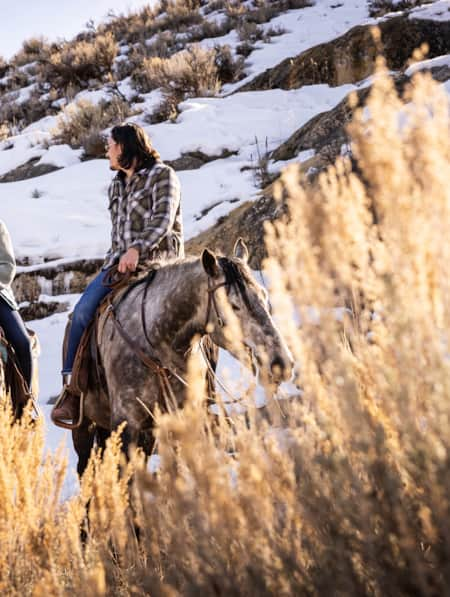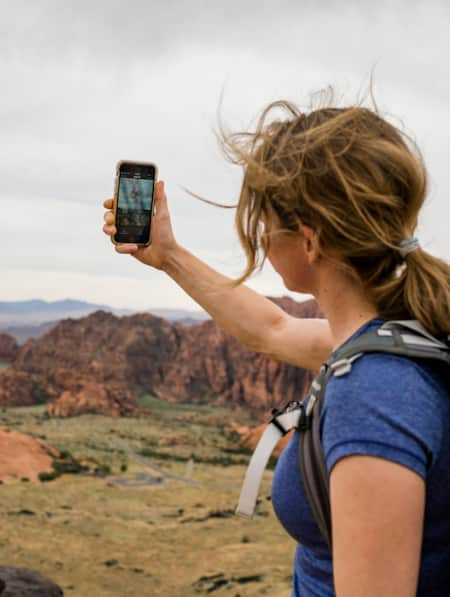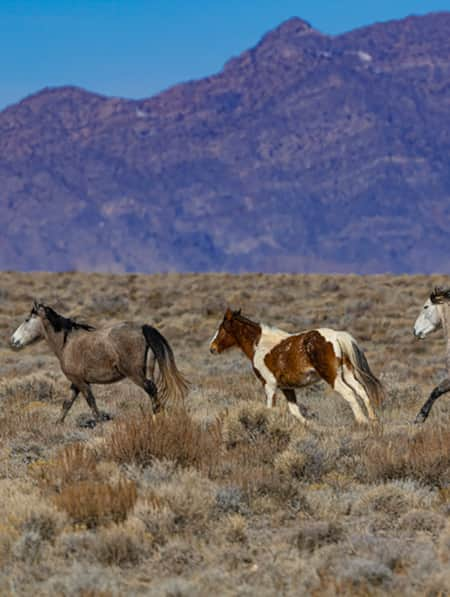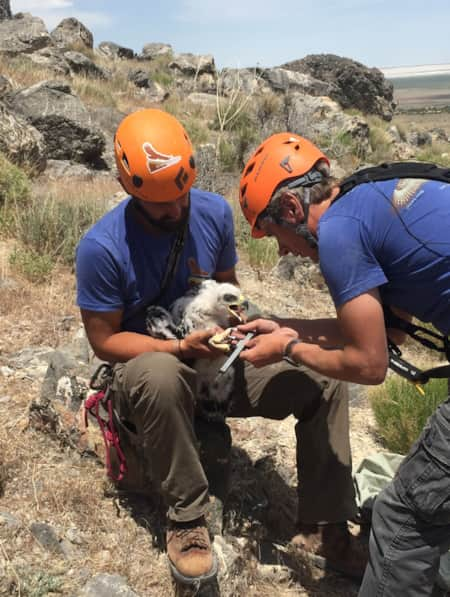Winging It
Explorations Within and Around the Gateway to the World's Greatest Wild Bird Refuge

I needed to see a pheasant.
For a relatively common bird, often found among the golden waves of Utah’s agricultural grasslands, the ring-necked pheasant had so far eluded me at every turn. I’ve birded the places they’re known to inhabit — including the undeveloped areas west of Farmington and the surprisingly birdy Antelope Island State Park — but have come up empty. I didn’t expect to see a small flock of them wandering across the road on my way to the Bear River Migratory Bird Refuge, but that was the first thing I saw and (after checking the pheasant off my life-list) the morning only got better from there.


Photo: Marc Piscotty

The iconic arch welcomes travelers to Brigham City, the Gateway to the World's Greatest Wild Bird Refuge.
Photo: Marc Piscotty


The Spiral Jetty meets rabbitbrush in bloom.
Photo: Sanda Salvas
Let Your Soul Take Flight
Situated at the junction of two of North America’s most-traveled migratory flyways, the Refuge is a magnet for birds — and for birders. Look to your right and watch a yellow-headed blackbird dart from the tip of a cattail into a midge swarm to catch its lunch. Look to the left, and you might see a pair of western grebes dance their mating steps across a pond as smooth as glass. Up ahead is a sea of white: it turns out to be thousands of American pelicans that have flown up and over the Promontory Mountains to find fish in the wetlands before flying back to their island nests on the Great Salt Lake.
The best place to start tours of the area is at the Refuge’s visitor’s center. Here, you can learn more about the Refuge’s unique wetlands ecosystem and borrow a field guide to identify the many species you’ll see out in the wild. You’ll discover that the power of this place lies in its location and fertility. Notice how much activity surrounds you as you’re watching for birds and other wildlife. The park offers an auto tour and paved trails to access viewing areas.
The Pacific and Central flyways diverge over northeastern Utah on the esdge of the Great Basin which, for the next several hundred miles, is largely desert. For many species, the Refuge is a vital stopover before undertaking the next leg of a long journey — a journey that offers few chances for respite. More than 200 species of birds visit the Refuge annually to benefit from the fertile grounds. As the Bear River flows out of the mountains and toward its terminus at the Great Salt Lake, it brings nutrients and refreshment to the Refuge. It’s a great place to rest and recharge for animals that will fly several thousand miles along their migratory trail in just a few months.
The Refuge is a great place for the human species to rest and recharge as well. While the far edge of the publicly accessible area of the wetlands is only a few miles from civilization, it feels like the middle of nowhere in the very best way. This is nature — park the car, get out and experience it. Smell the earthy vegetal scent of a living wetland. Close your eyes and listen to the variety of calls, from geese to wrens to frogs.
Feel what it’s like to be in a place that’s pulsating with natural life. (Read: Great Salt Lake Needs Your Visit)
Stop & See the City!
Most people know Brigham City as the town you stop in for fruit on your way to Logan. But that does this quiet Utah town a serious disservice. Brigham City, located on the eastern side of the Bear River Migratory Bird Refuge, is rich with history just waiting to be discovered. The city was founded in the early 1850s by Mormon pioneers, and many buildings and artifacts from the time have survived. The Brigham City Museum of Art & History is home to a permanent exhibition on the history of the city, and five temporary historical and fine art exhibitions a year.
One of the best-preserved areas of Brigham City is Main Street. The feel of the town mixes the tactile weight of historic buildings with the youthfulness of funky shops and eateries. My wife found something she loved in nearly every boutique and antique shop we browsed, and we very nearly had to rent a U-Haul to bring home a certain turquoise desk she discovered on our tour of local shops.
Surprises like these abound on Main Street. Many of the downtown shops have little consignment areas, where local vendors can display and sell their wares, be they handmade clothing and soaps, essential oil blends, or knick-knacks and restored furniture pieces. Each little shop has its own feel and purpose.
When taking in Main Street, consider making a first stop at Peach Tree Shave Ice for a treat to beat the heat. Tiger blood is their undisputed No. 1 flavor (because tiger blood is the best), with kid-favorite bubble gum coming in at No. 2. But don’t discount some of the more unique options — I tried fireball, which was like eating icy cinnamon fire.
Sunday morning, we discovered Bert’s Cafe & Grill, which was one of the few non-chain eateries that was open. We’re sure glad we did. The nostalgia factor is high at Bert’s, which is basically the epitome of a small-town greasy spoon diner. It’s the kind of place where the people are friendly, the country gravy is plentiful and delicious, and you can’t help but clean your plate.
Go West, Young Fam!
To get to Golden Spike National Historic Site, head west: The same direction traveled by the men of the Union Pacific Railroad as they laid track tirelessly toward a rendezvous with the Central Pacific Railroad. After tense negotiations to decide the meeting spot, the two groups finally came together on May 10, 1869 at Promontory, Utah, with the driving of the Golden Spike and the official opening of the First Transcontinental Railroad. The location of the meeting was in the middle of nowhere in 1869, and it remains remote to this day.
Golden Spike is about 40 minutes from Brigham City, set amid rolling hills of grassland and sagebrush. The site celebrates the herculean efforts of the teams of men who laid thousands of miles of steel and lumber that finally connected the east and west coasts. In the warmer months, visitors can see a restored train from that expansionary era as it pulls up to the spot where the spike was driven. The video in the visitor’s center offers an excellent overview of the rail line’s construction. It really puts this massive undertaking into perspective. (Read: Arrive by Train.)
Out here, if you’re lucky, you can also find one of the vanishingly rare greater sage-grouse leks. On early spring mornings from February to April, the sage-grouse gather in large numbers as the males perform their intricate mating dance in hopes of impressing the opposite sex. The dance is reputed to be astonishing and one of the more elaborate avian displays in this hemisphere. However, despite numerous stops to scan tantalizing patches of bare earth and sagebrush, the greater sage-grouse remains unchecked on my life list.
Land Meets Art
Spiral Jetty is a public art installation or “Earth Art” that is miles away from any human habitation. The only regular viewers are the flocks of American white pelicans that gaze down on it from above. Every day, these birds fly from their nesting grounds on Gunnison Island in the Great Salt Lake and over the Promontory Mountains on their way to find food at the Bear River Migratory Bird Refuge. Humans who want to see the sculpture must go out of their way to do so, but it’s worth the trip.
Created in 1970 by artist Robert Smithson and local laborers, Spiral Jetty is an enormous spiral of black basalt rock that extends from the shore and out into the lake. When in drought, the jetty is visible as a black spiral on a brilliant white salt plain; when it’s wet, the jetty is hidden beneath the lake’s saline waves.
When we visited in early spring, the jetty coiled out like a rocky tentacle toward the lapping edge of the lake. We traced the spiral from tip to center, hopping from stone to stone, then walked across the dazzling bright salt flat to the water’s edge. After a quarter-mile journey, we finally reached the shore and the pillows of salt-foam that had built up along it after the previous day’s windstorms. I stood and stared out at the horizon, disoriented by the sight of clouds meeting water, unable to tell where one started and the other began.
Read more about the Spiral Jetty
Smithson was reportedly interested in the concept of “entropy” when creating Spiral Jetty and over time, as the elements and returning tide weather away the sculpture, his vision will be realized.
For the Life List
Back in Brigham, we grabbed some ice cream at the Frozen Udder and struck up a conversation with a local couple. We chatted for nearly an hour about the area, family activities and, of all things, the joys of raising chickens. (Thanks, new friends, for selling my wife on the idea!) They suggested a day trip to nearby Crystal Hot Springs for a dip in its rejuvenating mineral waters, and a hike past Mantua Reservoir, where the alpine flowers carpet the valleys. Those things will have to wait for our next visit — and there will definitely be a next visit: I saw my pheasant at the Refuge, now I’m looking for a bittern.
Start Planning
Sometimes you just need to slow life down a little. My wife, son and I needed a weekend getaway to relax and reset ourselves for a few days. We chose to include a visit to tranquil Brigham City, to get out of the valley and explore areas of Utah we’d never really been before. If you decide to go, here is some more information. — Steve Gooch
The Bear River Migratory Bird Refuge is located at 2155 W Forest St, Brigham City, UT 84302.
Golden Spike National Historic Site is located 32 miles west of Brigham City, Utah, via Utah Highway 83.
More Places to Go
ATK Rocket Garden: 9160 N. Hwy. 83 (30 mins from Brigham City)
Brigham City Museum of Art and History: 24 N. 300 W.
Brigham City Tabernacle: 251 S Main St.
Crystal Hot Springs: 8215 North Highway 38, Honeyville.
Utah’s Famous Fruitway: Fresh fruit stands along Highway 89 from Brigham City to Willard.
Food to Eat
Maddox Ranch House: 1900 S. Highway 89
Peach Tree Shave Ice: 58 S. Main St.
Bert’s Cafe & Grill: 89 S. Main St.
Frozen Udder Ice Cream: 646 S. Main St.
Seasonality
Spring and Fall are the best months to see thousands of migrating birds at the Bear River Migratory Bird Refuge. Learn more from refuge biologist Howard Browers. Summer and Fall are the best times to peruse Fruitway (Highway 89 between Brigham City and Willard) for fresh local produce. The road to Spiral Jetty is maintained gravel, so it’s best to visit during drier months.
Traveling with Children
Most kids will find interesting things at any stop in the area. Nature lovers will love the Refuge. Science lovers will like ATK’s Rocket Garden. All kids will get a kick out of picking their own fruit along Fruitway.
Tip
The Spiral Jetty is located on Rozel Flats Rd. about 30 minutes from Golden Spike. Ask for directions at Golden Spike if you're not sure.
More Birding and Railroad History
-

Antelope Island State Park
Antelope Island State Park is 25 miles north of Salt Lake City. Accessed by a causeway, the island sits in Great Salt Lake and features free-roaming bison and antelope herds.
-

Golden Spike
Visit the Golden Spike National Historic Park to relive the history with exhibits and demonstrations, and take in the beauty of the surrounding Great Basin Desert and nearby Great Salt Lake and Spiral Jetty.
-

Willard Bay State Park
Today Willard Bay State Park is a freshwater reservoir that is located only miles from both Ogden and Brigham City, UT, and offers awesome camping and boating, excellent birding and exciting fishing.

.jpg?w=450&h=294&mode=crop&quality=65)



























